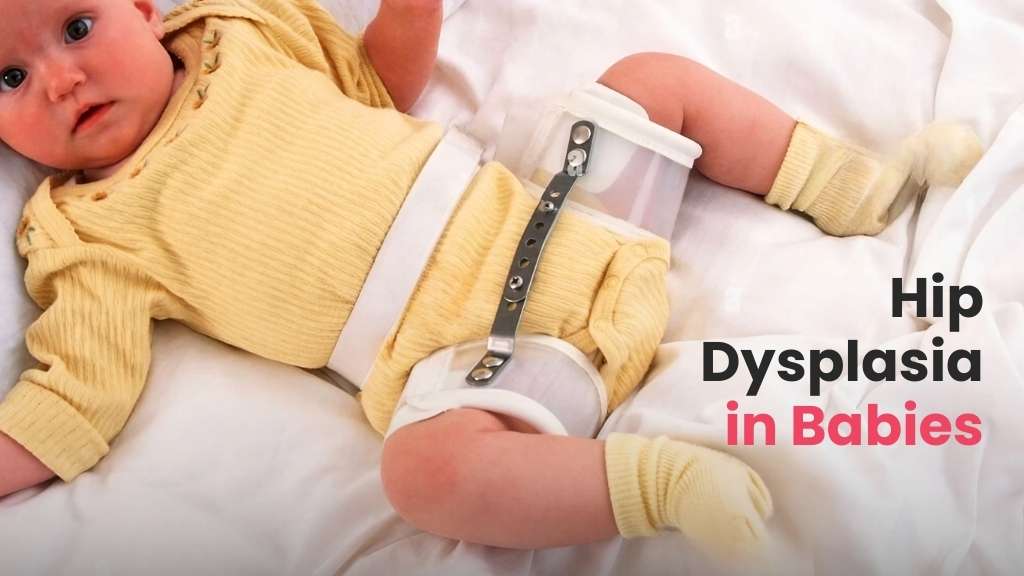
Table of Contents
Hip dysplasia in babies is a medical condition that affects the hip joint’s development in infants. It’s crucial to catch and address this condition early on to ensure proper hip joint function and overall health. In this blog, we will delve into the causes, diagnosis, and treatment options for hip dysplasia in babies.
Causes of Hip Dysplasia In Babies
What causes hip dysplasia in babies? Well, hip dysplasia occurs when the hip joint doesn’t develop normally, leading to instability or misalignment. There are several factors that can contribute to the development of this condition:
1. Genetics: A family history of hip dysplasia can increase a baby’s risk of developing the condition.
2. Positioning in the Womb: Babies positioned in a breech (buttocks-first) position in the womb have a higher risk of hip dysplasia as their hip joints may not have enough room to develop properly.
3. Gender: Girls are more prone to hip dysplasia than boys.
4. Swaddling and Tight Wrapping: Overly tight swaddling or wrapping of the baby’s legs can restrict hip movement and contribute to hip dysplasia.
Diagnosing Hip Dysplasia In Babies
Early diagnosis is crucial for effective treatment. Paediatricians often conduct physical exams and use imaging techniques to assess the baby’s hip joint:
1. Ortolani and Barlow Tests: These physical tests involve gentle manipulation of the baby’s hip to detect instability or dislocation.
2. Ultrasound: In infants younger than six months, ultrasound imaging can provide a clear view of the hip joint’s structure.
3. X-rays: For older infants, X-rays may be used to diagnose hip dysplasia and determine its severity.
Treatment For Hip Dysplasia In Babies
The treatment approach for hip dysplasia in babies largely depends on the baby’s age, the severity of the condition, and the hip’s stability. Treatment methods include:
1. Pavlik Harness: For infants under six months, a Pavlik harness is often used. This soft brace helps position the hip joint correctly and allows controlled movement.
2. Spica Cast: If the condition is more severe, a spica cast may be applied to hold the hip joint in the correct position. This requires more immobilization but can be effective in reshaping the joint.
3. Surgery: In some cases, surgical intervention may be required. Surgical procedures can involve repositioning the hip joint or reshaping the socket to ensure stability and proper development.
Long-Term Outlook
With early detection and appropriate treatment, the outlook for babies with hip dysplasia is generally positive. Most babies respond well to non-surgical treatments and go on to have normal hip joint function. Regular follow-ups with a pediatric orthopedic specialist are important to monitor progress and make any necessary adjustments to the treatment plan.
Prevention and Awareness of Hip Dysplasia In Babies
To reduce the risk of hip dysplasia in babies, it’s essential to be aware of proper hip-healthy practices:
- Avoid Tight Swaddling: Allow room for the baby’s hips to move freely.
- Provide Frequent Diaper Changes: Frequent diaper changes can help prevent hip issues caused by prolonged adduction (bringing the thighs together).
- Encourage Tummy Time: Tummy time helps develop hip muscles and promotes healthy hip joint development.
In conclusion, hip dysplasia is a condition that requires prompt attention and appropriate treatment. With early diagnosis and intervention, babies affected by this condition can have a positive long-term outcome.
Parents and caregivers should stay informed about proper hip-healthy practices to ensure the well-being of their babies’ hip joints. If you suspect your baby might have hip dysplasia, consult a pediatrician or orthopedic specialist for guidance.
What Are The Hip Dysplasia In Babies Signs?
Developmental dysplasia of the hip (DDH) can have varying degrees of severity, and the signs and symptoms can differ based on the age of the child. Here are some common signs of hip dysplasia in babies:
In Infants
- Asymmetry: One leg might appear shorter than the other, or there may be an apparent difference in the skin folds on the thighs or buttocks.
- Limited Hip Movement: The hip may have a limited range of motion, and the affected leg may not move as freely as the other.
- Clicking or Clunking Sensation: You might notice a clicking or clunking sound when moving the baby’s hip joint, especially during diaper changes.
- Uneven Gluteal (Buttock) Folds: The folds of skin on the buttocks may appear uneven when the baby is lying on their back with the knees bent and the feet flat on the surface.
- Leg Positioning: The affected leg may turn outward or look like it’s being held in an unusual position when the baby is lying on their back.
In Older Children
Limping: As the child begins to walk, you might notice a limp or abnormal gait.
Pain: Older children might complain of pain in the hip, groin, or thigh area.
Limited Range of Motion: The affected hip may have limited movement, and the child might have difficulty spreading their legs.
Asymmetry: Similar to infants, there may be an apparent difference in leg length or skin folds on the buttocks or thighs.
It’s important to note that some babies born with DDH may not show any obvious signs or symptoms, which is why early screening and evaluation are crucial, especially for infants who are at a higher risk due to family history or breech positioning in the womb. Regular check-ups with a pediatrician and proper hip examinations can help catch any issues early on.
If you notice any of these signs or if you have concerns about your child’s hip development, it’s advisable to consult a pediatrician or a medical professional who specializes in pediatric orthopedics. Early diagnosis and appropriate treatment can significantly improve the long-term outcomes for children with developmental dysplasia of the hip.
What Is Hip Laxity?
Hip laxity refers to the looseness or instability of the hip joint. It occurs when the ligaments, muscles, and other soft tissues that hold the hip joint together are not as tight or supportive as they should be. This can lead to excessive movement within the joint, potentially causing issues with joint alignment and stability.
In the context of developmental dysplasia of the hip (DDH), hip laxity is often a key factor. Babies born with hip laxity have hip joints that are more prone to dislocation or improper alignment. The hip joint may be more easily moved out of its normal position, which can hinder proper joint development.
Hip laxity can manifest as increased mobility of the hip joint, leading to a feeling of “clicking” or “clunking” as the joint moves in and out of its socket. In babies, hip laxity can be a significant risk factor for DDH, as it allows the hip joint to move too freely, potentially leading to improper hip socket development.
Medical professionals often use specific tests, such as the Ortolani and Barlow tests, to assess hip laxity in infants. These tests involve gently manipulating the baby’s hip joint to detect any instability or dislocation.
Addressing hip laxity and any associated conditions, such as DDH, early on is crucial to ensure proper hip joint development and prevent long-term complications. Treatment options, such as harnesses, casts, or surgery, may be recommended based on the severity of hip laxity and its impact on joint stability. Regular follow-ups and monitoring are essential to track progress and make informed decisions about treatment.





